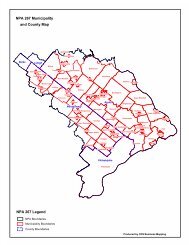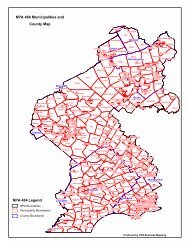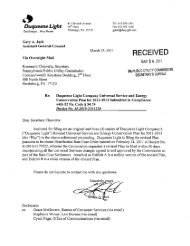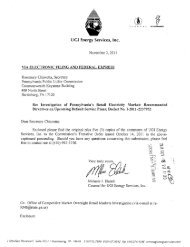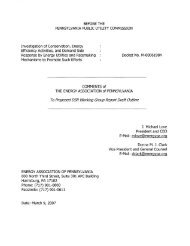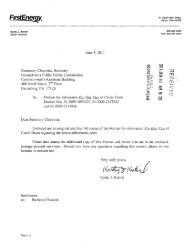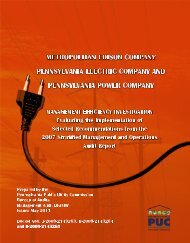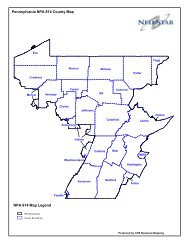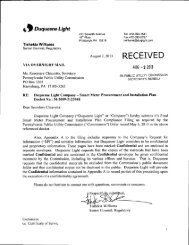2010 Report - Pennsylvania Public Utility Commission
2010 Report - Pennsylvania Public Utility Commission
2010 Report - Pennsylvania Public Utility Commission
You also want an ePaper? Increase the reach of your titles
YUMPU automatically turns print PDFs into web optimized ePapers that Google loves.
2000. Average annual use per residential customer was 1,218 kWh at an average cost of 11.38cents per kWh; operating revenues totaled $1.32 billion.Between 1994 and 2009, Met-Ed’s energy demand grew at an average rate of 2.1 percent per year.Residential and commercial sales have maintained relatively steady growth over the period (2.2percent for residential and 3.0 percent for commercial), while industrial sales have fluctuatedconsiderably. Industrial sales declined at an average rate of 0.8 percent, attributable to the steepdrop in 2009. The current five-year projection of growth in total energy demand is 1.9 percent.This includes a residential growth rate of 1.3 percent, a commercial growth rate of 1.7 percent andan industrial rate of 3.2 percent. See Figure 30.Met-Ed’s summer peak load, occurring on Aug. 10, 2009, was 2,739 MW, representing a decreaseof 10.0 percent from last year’s system peak of 3,045 MW. The 2009-10 winter peak load was2,342 MW or 10.7 percent lower than the previous year’s winter peak of 2,622 MW. The actualaverage annual peak load growth rate over the past 15 years was 2.1 percent. Met-Ed’s forecastshows its peak load dropping from 2,739 MW in 2009 to 2,630 MW in 2012 and increasingthereafter to 2,731 MW by 2014. The current forecast for <strong>2010</strong> is 245 MW or 8.4 percent belowthe previous forecast. See Figure 31.Figure 32 depicts the average of deviations in forecasts made one to three years in advance. TablesA05-A08 in Appendix A provide Met-Ed’s forecasts of peak load and residential, commercial andindustrial energy demand, filed with the <strong>Commission</strong> in years 2000 through <strong>2010</strong>.A restructuring settlement, approved by the <strong>Commission</strong> in 1998, provided for the transfer of 80percent of Met-Ed’s POLR responsibility to other generation suppliers by June 2003. Since thisdid not occur, Met-Ed retains POLR responsibility for those customers who do not choose analternate energy supplier and currently supplies nearly all of its POLR customers. Met-Ed does notown any generating facilities.In 2009, Met-Ed purchased 2,202 GWh from cogeneration and small power production projects,representing 15.3 percent of net energy for load. Contract capacity (defined as PJM installedcapacity credits) is 295 MW of a total capacity of 355 MW. For Calendar Year 2009, two EGSsold a total of 21 GWh to retail customers in Met-Ed’s service territory. There were nooccurrences where EGSs were unable to supply scheduled loads during 2009.Through 2013, Met-Ed’s transmission line projects include construction of new lines andreconductoring of existing lines to improve local service at a combined cost of $4.1 million.Projects include 11.1 miles of 69 kV, 115 kV and 230 kV circuits.Met-Ed’s Energy Efficiency and Conservation Plan 58 offers a suite of programs for all customersegments designed to reach cumulative reduction targets of 446 GWh and 119 MW at a total costof $99.5 million.Met-Ed is a member of PJM and RFC.58 Docket No. M-2009-2092222.36<strong>Pennsylvania</strong> <strong>Public</strong> <strong>Utility</strong> <strong>Commission</strong>



